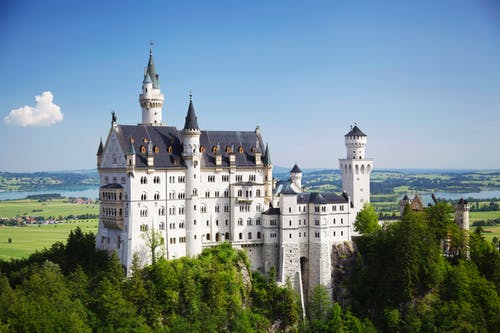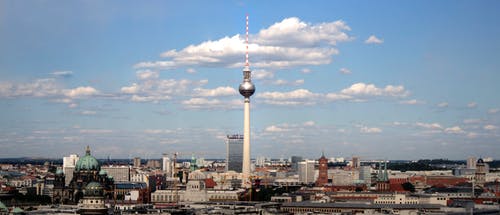 Germany's climate is moderate and has generally no longer periods of cold or hot weather.
Northwestern and coastal Germany have a maritime influenced climate which is characterized
by warm summers and mild cloudy winters. Most areas on the country's North Sea coast have
midwinter temperatures about 1.5°C or even higher. Farther inland, the climate is
continental, marked by greater seasonal variations in temperature, with warmer summers and
colder winters. Temperature extremes between night and day and summer and winter are
considerably less in the north than in the south. During January, the coldest month, the
average temperature is about 1.5°C in the north and about -2°C in the south. In July, the
warmest month, it is cooler in the north than in the south. The northern coastal region has
July temperatures averaging between 16°C and 18°C; at some locations in the south, the
average is almost 20°C or even slightly higher.
Germany's climate is moderate and has generally no longer periods of cold or hot weather.
Northwestern and coastal Germany have a maritime influenced climate which is characterized
by warm summers and mild cloudy winters. Most areas on the country's North Sea coast have
midwinter temperatures about 1.5°C or even higher. Farther inland, the climate is
continental, marked by greater seasonal variations in temperature, with warmer summers and
colder winters. Temperature extremes between night and day and summer and winter are
considerably less in the north than in the south. During January, the coldest month, the
average temperature is about 1.5°C in the north and about -2°C in the south. In July, the
warmest month, it is cooler in the north than in the south. The northern coastal region has
July temperatures averaging between 16°C and 18°C; at some locations in the south, the
average is almost 20°C or even slightly higher.
More information here
Natural Features
TOTAL AREA (SQ MI): 137,879 -- TOTAL AREA (SQ KM): 357,104
Germany is located in central Europe. Germany is bordered by the Baltic and North Sea,
Denmark to the north, Poland and the Czech Republic to the east, Austria and Switzerland
to
the south, and France, Luxembourg, Belgium, and the Netherlands to the west.
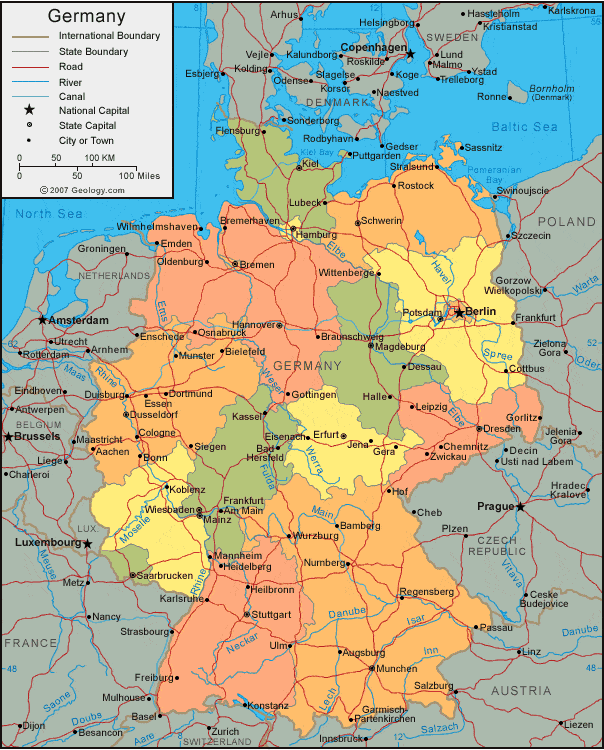
BERLIN
As the country’s capital, you’ll be pressed to find a German city more diverse than Berlin. With an estimated population of 3.7 million, Berlin is the European Union’s second most populous city and is home to a wide range of people with truly diverse backgrounds and cultures.Though it may be a metropolis with an impressive city skyline and plenty of shopping options, one-third of Berlin is covered in lush forests, quaint parks and gardens, rivers, canals and lakes. But of course, one of the city’s main tourist appeals is its diverse history. A tour of Berlin will certainly include some monumental sights, such as the Berlin Wall (including Checkpoint Charlie), which is also one of the top tourist attractions in Germany; the Brandenburg Gate, the Holocaust Memorial, and a range of fascinating museums.
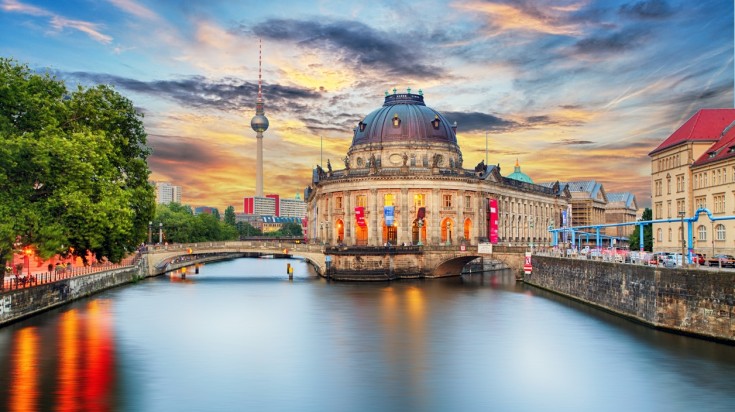
MUNICH
Munich is the capital of Bavaria, a German state with its own unique culture. Bavaria is home to a range of traditions that are quite diverse from the rest of Germany, including Oktoberfest (a popular annual celebration that typically involves plenty of beer) as well as traditional clothing like the lederhosen and dirndl.Munich can be found nestled within the Bavarian Alps, along the River Isar. Visit this city for some of the world’s best beer gardens, a couple of fairytale palaces (The Residenz and the Nymphenburg Palace), and delicious, fresh pretzels! Museum buffs will be particularly fond of Munich, which is home to over 80 museums celebrating everything from modern art to potatoes (yes, the vegetable).

HEIDELBERG
Heidelberg is one of the world’s oldest student towns, hosting Germany’s oldest and most well-known university, reflected in the city’s youthful, energetic atmosphere. While a city by definition, Heidelberg is completely surrounded by lush forests, with the Neckar River winding through it, so you’ll never feel far from nature.Be sure to visit the Old Bridge (beautiful in and of itself, it also gives spectacular views of the city), the partially-restored Heidelberg Castle ruins, which is one of the most visited tourist attractions in Germany as well, and the Sammlung Prinzhorn, a fascinating museum featuring art from psychiatric inmates from 1840–1945.
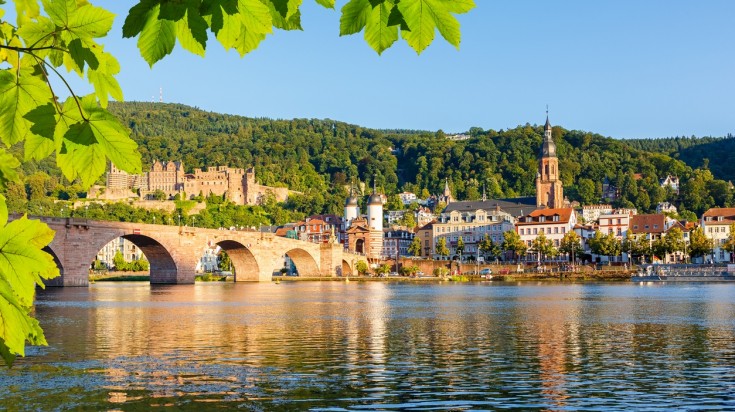
Sanssouci Palace

In the heart of Sanssouci Park in the city of Potsdam, you’ll find the incredible New Palace, often referred to as Sanssouci Palace. Built in the 18th century under the commission of Frederick the Great, the palace is a beautiful example of baroque architecture and design. On a tour of Sanssouci Palace, you can see the opulent Grotto Hall, which was plastered with shells, marble and semi-precious stones, as well as an extensive art collection and an enormous rococo theater. While there, be sure to stroll through the gardens, which are meticulously cared for and serve as the perfect spot for a scenic picnic.
Monument to the Battle of the Nations

The city of Leipzig is an industrial hub and a cultural destination in Germany, but what it is best known for is the Völkerschlachtdenkmal, or the Monument to the Battle of the Nations. The monument, which is nearly 300 feet (91 meters) high, was erected at the 100th anniversary of the Battle of Leipzig. The Monument to the Battle of the Nations is stunning in its own right, but it also offers an amazing vantage point over the city. If you climb 500 steps to the top, you can look out over much of Leipzig and enjoy the view.
Nuremberg Christmas Market
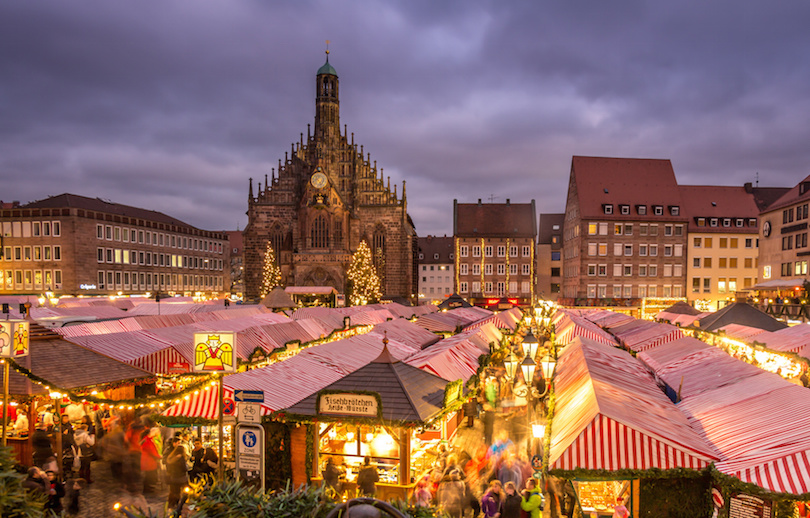
There is no bad time to visit Germany, but there is something truly magical about visiting during the holidays. In November of each year, Nuremberg transforms into a winter wonderland thanks to its Christkindlesmarkt, or outdoor Christmas market. Among historic buildings and on cobblestone streets, you can shop for handcrafted wooden ornaments while sipping gluhwein, a warming spiced red wine sold by street vendors. If you get hungry while browsing the nearly 200 stalls, snack on the ubiquitous Drei im Weggla, or three sausages in a bread roll, and some lebkuchen, or traditional Nuremberg spiced gingerbread, for dessert.

